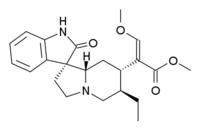Rhynchophylline
Rhynchophylline is an alkaloid found in certain Uncaria species (Rubiaceae), notably Uncaria rhynchophylla[1] and Uncaria tomentosa.[2] It also occurs in the leaves of Mitragyna speciosa (kratom),[3] a tree native to Thailand. Chemically, it is related to the alkaloid mitragynine.
 | |
| Names | |
|---|---|
| IUPAC name
Methyl (7β,16E,20α)-16-(methoxymethylene)-2-oxocorynoxan- 17-oate | |
Other names
| |
| Identifiers | |
CAS Number |
|
3D model (JSmol) |
|
| ChEBI | |
| ChEMBL | |
| ChemSpider | |
| ECHA InfoCard | 100.208.612 |
| KEGG | |
PubChem CID |
|
| UNII | |
InChI
| |
SMILES
| |
| Properties | |
Chemical formula |
C22H28N2O4 |
| Molar mass | 384.476 g·mol−1 |
Except where otherwise noted, data are given for materials in their standard state (at 25 °C [77 °F], 100 kPa). | |
| Infobox references | |
Rhynchophylline is a non-competitive NMDA antagonist (IC50 = 43.2 μM) and a calcium channel blocker.[4][5]
Uncaria species have had a variety of uses in traditional herbal medicine, such as for lightheadedness, convulsions, numbness, and hypertension.[6] These uses have been associated with the presence of rhynchophylline and have encouraged its investigation as a drug candidate for several cardiovascular and central nervous system diseases; however, few clinically relevant studies have been conducted.[6]
See also
- Mitragynine pseudoindoxyl
- Proboscidea parviflora
References
- Shi JS, Yu JX, Chen XP, Xu RX (2003). "Pharmacological Actions of Uncaria Alkaloids, Rhynchophylline and Isorhynchophylline" (pdf). Acta Pharmacologica Sinica. 24 (2): 97–101. PMID 12546715.
- Mohamed AF, Matsumoto K, Tabata K, Takayama H, Kitajima M, Watanabe H (2000). "Effects of Uncaria tomentosa Total Alkaloid and its Components on Experimental Amnesia in Mice: Elucidation Using the Passive Avoidance Test". Journal of Pharmacy and Pharmacology. 52 (12): 1553–1561. doi:10.1211/0022357001777612. PMID 11197086.
- "Mitragyna Speciosa (Kratom) - World Roots".
- Kang TH, Murakami Y, Matsumoto K, Takayama H, Kitajima M, Aimi N, Watanabe H (2002). "Rhynchophylline and Isorhynchophylline Inhibit NMDA Receptors Expressed in Xenopus Oocytes". European Journal of Pharmacology. 455 (1): 27–34. doi:10.1016/S0014-2999(02)02581-5. PMID 12433591.
- Kang TH, Murakami Y, Takayama H, Kitajima M, Aimi N, Watanabe H, Matsumoto K (2004). "Protective Effect of Rhynchophylline and Isorhynchophylline on in vitro Ischemia-Induced Neuronal Damage in the Hippocampus: Putative Neurotransmitter Receptors Involved in their Action". Life Sciences. 76 (3): 331–343. doi:10.1016/j.lfs.2004.08.012. PMID 15531384.
- Zhou J, Zhou S (2010). "Antihypertensive and neuroprotective activities of rhynchophylline: the role of rhynchophylline in neurotransmission and ion channel activity". Journal of Ethnopharmacology. 132 (1): 15–27. doi:10.1016/j.jep.2010.08.041. PMID 20736055.